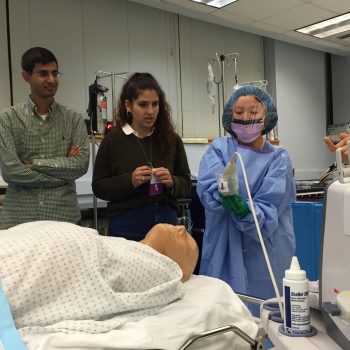How do bottles of Coca Cola reach even the most remote regions of the world, while essential medicines for conditions like diarrhea remain unobtainable?
Simon Berry noticed this discrepancy while working with the British Overseas Development Agency in Northern Zambia in the 1980s. Dehydration from diarrhea can be easily treated with low-cost interventions such as oral rehydration therapy, yet diarrhea remains a leading cause of death in children under five worldwide. Berry wondered whether the empty spaces in each crate of Coca Cola could be used for drug delivery. Two decades later, he invented the Kit Yamoyo, a self-contained aid-pod with oral rehydration salts and zinc tablets for treating diarrhea. The Kit Yamoyo went on to win many design awards and, in initial trials in Zambia, increased the share of sick children receiving treatment from less than 1% to 45%.1
The Kit Yamoyo is merely one example of how design can be harnessed to tackle significant public health problems. Design does not deal merely with aesthetics or superficial beautification – at its core, it provides a strategy for critically analyzing problems and creating solutions that enhance our lives. It addresses the social and cultural elements that are as critical to health as scientific and clinical advances. Other fields, from technology to business to education, have recognized the value of design and creativity and integrated these approaches into their work. To tackle the complex healthcare issues we face today, we need to follow their lead and make design a fundamental part of medical research, education, and practice.
Better Health, By Design
As advancements in technology provide us with increasing resources at our disposal – from minimally invasive surgical tools to 3D printed organs to the current surge in wearable technology – design plays a critical role in how we implement these technologies to positively impact health.(a)
Nowhere is the evidence for design’s ability to advance healthcare clearer than in the development of medical devices. Insulin pens are a prime example. For decades, patients with insulin-dependent diabetes have had to manage their blood sugar by frequently injecting themselves with syringes after manually drawing insulin from a vial. This process is cumbersome and requires fine dexterity; since peripheral nerve damage is a common complication of diabetes, it can often be difficult for patients to do themselves. Since the advent of insulin pens in 1985, patients can now administer their medication with convenient, discreet, one-touch devices. Studies have shown that these pens increase medication compliance, provide more accurate dosing, and improve user satisfaction.2
The design of physical space is another promising way to improve health. In the clinical setting, environment has a considerable impact on the delivery of care by either enhancing or inhibiting providers’ natural workflows.(b) For example, a redesign of the coronary care unit at Indiana University Health’s Methodist Hospital reduced the number of patient rooms, but each room became more versatile and adaptable to changes in the severity of the patient’s condition.3 Patients could be admitted and discharged from the same room, allowing for a 90% reduction in patient transports and handoffs. This led to 70% fewer medication errors and to greater efficiency, permitting more time for direct nursing care. Additional studies have found that specific design elements can contribute significantly to improved patient outcomes.4 For instance, exposure to sunlight and views of nature from hospital rooms have been shown to decrease patients’ stress, pain, and the length of their stay.
Integrating Different Worlds
Despite the success of individual design solutions in addressing health problems, there are still several barriers to institutionalizing a greater integration of design and healthcare. First, practitioners in each field approach their goals in fundamentally different ways. Physicians are trained to be analytical, to follow guidelines and procedures, and to support their actions with clear evidence and rationale. Designers, on the other hand, are encouraged to be empathetic and creative, to experiment with ideation, and to challenge the status quo.
This does not mean that the practice of medicine lacks creativity or that design is not rigorous or systematic. Rather, these very distinct lenses through which doctors and designers approach problem solving can contribute to ineffective communication and difficulty in recognizing the potential benefits that the other party brings to the table. Moreover, our healthcare system is so mired in complexity that even experts struggle to grasp it as a whole. Layers of bureaucratic red tape obstruct or dissuade non-healthcare personnel from entering and understanding the clinical environment.
Just as important is the need for thorough, peer-reviewed research on design’s role in medicine. Although design is understood to influence health, the mechanisms of how it helps and the extent to which it helps have not yet been analyzed in a systematic manner. In a review of existing literature on the impact of healthcare facility design, researchers found that “well-designed physical settings play an important role in making hospitals safer and more healing,” but noted that existing evidence, particularly high-quality randomized controlled trials, is limited.6 Until more rigorous research is performed to evaluate the impact of specific design interventions on patient outcomes, as well as the pathways by which these interventions have an effect, it will be difficult for the value of design to garner full acceptance within the medical community.
A Systemic Role for Design
The next phase in the integration of design into healthcare is a move from individual successes like the Kit Yamoyo and the insulin pen to a more formal, robust incorporation of design as a fundamental component of medicine. The Mayo Clinic’s Center for Innovation (CFI) represents one institution’s attempt to officially bridge medicine and design by employing an in-house interdisciplinary team that uses design thinking to solve health problems. One outcome of CFI’s efforts is the Jack and Jill Consult Room, developed after the team realized that the majority of patient-doctor interactions revolve around conversation rather than the physical exam. The team redesigned the traditional exam room to accommodate this dynamic, a change that served to improve workflow as well as patient and provider satisfaction.(c)
Despite calls for innovation in the areas of academic medicine and medical education, there are still relatively few formalized education and research endeavors that wed medicine and design.7 Pioneering initiatives like the University of Virginia’s Center for Design & Health and the Texas A&M University’s Center for Health Systems & Design are pushing for interdisciplinary collaboration and research at an institutional level, but even these visionary programs tend to limit their scope to topics such as health facility design and urban planning. Programs like the Stanford BioDesign Innovation Fellowship and the “Innovative Thinking” course at the University of Texas Health Science Center at Houston aim to instill design thinking among participants, but are geared primarily towards post-graduate or graduate students and are situated outside the realm of primary medical education.

Students in the Design+Health class, a partnership between Brown University’s Alpert Medical School and the Rhode Island School of Design
Sending Design to School
There are few precedents for interdisciplinary, collaborative learning opportunities for design and medical students early in their education. During this critical phase, students are absorbing their respective disciplines with enthusiasm while also challenging traditional concepts and seeking out ways to incorporate progressive thinking into their future careers. Through early collaboration, these eager minds gain exposure to unique perspectives and expertise that can broaden their respective skill sets for problem solving. Medical students can acquire skills for innovative thinking and production and design students can gain conceptual grounding in clinical medicine and health in order to direct their creative talents.
To promote the value of cross-disciplinary collaboration, we created Design+Health, a developing partnership between the Alpert Medical School of Brown University and the Rhode Island School of Design (RISD).(d) One of Design+Health’s first projects is a joint course that seeks to increase awareness of the capacity of all fields of design to influence health, and to foster collaboration and effective communication between the health and design disciplines. By bringing together design students and medical students during their formative educational experiences, our goal is to break down traditional silos in education in order to unlock innovative capacity and create a new approach to best understand and respond to complex problems involving health.
The human element has always been as important to medicine as the scientific side. Design takes this human factor into account by analyzing how healthcare is provided and used and how the behavior of doctors, patients, and other actors promotes or impedes health. Through novel systems that bring medical resources to underserved areas, redesigned hospital and exam rooms that help providers offer better care, and medical devices that empower patients to improve their own health, design has a pivotal role to play in healthcare. What we need now is to integrate design as a fundamental component of medicine by creating opportunities for the two worlds to meet, from the classroom to the research lab to the clinical setting.
Endnotes
- Rohit Ramchandani (forthcoming) “ColaLife Operational Trial Zambia (COTZ) Evaluation,” Baltimore, MD: Johns Hopkins Bloomberg School of Public Health.
- Selam JL (2010) Evolution of Diabetes Insulin Delivery Devices, Journal of Diabetes Science and Technology, 4(3):505-513.
- Hendrich A, Fay J, and Sorrels A (2004) Effects of acuity-adaptable rooms on flow of patients and delivery of care, Am J Crit Care, 13:35-45.
- Walch J, Rabin B, Day R, Williams J, Choi K, and Kang J (2005) The effect of sunlight on postoperative analgesic medication use: a prospective study of patients undergoing spinal surgery, American Psychosomatic Society, 67:156-163. Ulrich R. (1984) View through a window may influence recovery from surgery, Science, 224:420-421. Benedetti F, Colombo C, Barbini B, Campori E, and Smeraldi E (2001) Morning sunlight reduces length of hospitalization in bipolar depression, Journal of Affective Disorders, 62:221-223. Malenbaum S, Keefe F, Williams A, Ulrich R, Somers T (2008) Pain in its environmental context: implications for designing environments to enhance pain control, Pain,134:241-244.
- McKinnon R, Bowles H, and Trowbridge M (2011) Engaging physical activity policymakers, Journal of Physical Activity and Health, 8(1):S145-S147.
- Ulrich R, Zimring C, Zhu X, DuBose J, Seo HB, Choi YS, Quan X, and Joseph A (2008) Healthcare leadership: white paper series: a review of the research literature on evidenced based healthcare design, The Center for Health Design.
- Ness, R (2011) Teaching Creativity and Innovative Thinking in Medicine and the Health Sciences, Acad Med, 86:1201–1203.
Sidenotes
- (a) Hackathons have recently expanded from computing and engineering into healthcare and medical devices. These events bring together participants with diverse skill sets to generate ideas and rapidly develop responses to specific challenges. At a health hackathon hosted by the MIT Hacking Medicine group and Massachusetts General Hospital, a physician and an engineer collaborated on a device to help infants who have difficulty breathing at birth, a problem that kills 1.8 million newborns a year. Within a matter of days, they created a working prototype for the Augmented Infant Resuscitator, a low-cost device that monitors and provides real-time feedback on resuscitation efforts.
- (b) Design can be just as potent outside of clinical settings, in the everyday living and working environments where peoples’ health is largely determined. Physical inactivity, along with poor diet, is the second leading cause of preventable death in the U.S. Efforts to design engaging and safe public spaces, such as parks, bike paths, and better sidewalks, can promote walking, running, bicycling, and the use of stairs to get people to move more.4
- (c) In a house, a Jack and Jill configuration refers to a bathroom with doors into two bedrooms located on either side. The Jack and Jill rooms at Mayo have an exam room with an attached conversation room on each side where doctors can meet and talk with patients before and after the physical exam.
- (d) Design+Health serves as an incubator for innovative ideas at the intersection of medicine and design. It aims to generate novel solutions to medical and public health challenges as well as new forms of research that promotes the use of design in healthcare.





